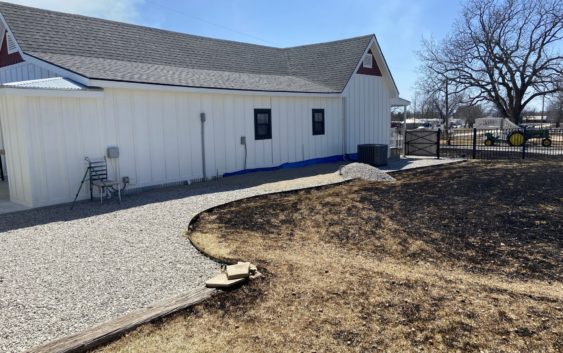- Severe weather leads to fallen trees, car crashes and flooding around the Triangle
- New video shows vehicles being swept away in historic, deadly flash floods in SA on June 12
- $40 million to go to underserved SC counties for Hurricane Helene recovery. Here's what you need to know.
- Family honors Air Force veteran Derwin Anderson Jr. after he died in June flash floods
- City of Wilmington addresses flooding on New Centre Drive
Protecting Homes From Wildfire

Barbara Peeler credits firefighters with saving her family’s ranch.
When a fire started on a highway bordering the A.M. Peeler Ranch in southern Atascosa County in March, Peeler said the response from emergency crews was swift and powerful.
The fire, which burned 2,900 acres, spread rapidly in tall grass and thick brush. However, it never threatened structures, thanks to the efforts of the Texas A&M Forest Service and local volunteer fire departments, she said.
“The response was unbelievable,” Peeler said. “They had multiple fire departments, bulldozers, helicopters, a big airplane. It could have gotten to some structures, but they caught it in time.”
Protection starts with homeowners
Fire officials have identified property owners as the primary line of defense in protecting their homes before a wildfire starts.
Since Jan. 1, Texas A&M Forest Service and local fire departments have responded to 11,679 wildfires that have burned 643,206 acres across the state.
In that time, firefighters saved 8,056 homes in the path of wildfire. Many of those homes had the first layers of protection — defensible space and fire-resistant construction materials — before firefighters arrived.
Defensible space — the area around a home that has been cleared of vegetation and other combustible material to provide a barrier against a wildfire — is critical to improving the chances a home can survive a wildfire, said Erin O’Connor, Texas A&M Forest Service public information officer.
“Property owners can make a major difference in the threat their homes face from wildfire by taking action well before a fire ever starts,” O’Connor said. “Anyone can make their home and community more fire resistant through landscaping and home maintenance techniques.”
Creating a defensible space
Creating a buffer of defensible space can slow or stop the spread of wildfires before they reach a home while providing safe areas in which firefighters can work to defend the structures.
Weldon Dent, Texas A&M Forest Service fuels specialist, said the area immediately surrounding the home is crucial in giving fire crews an advantage.
“What homeowners do in that first 5 feet around a home can make a difference,” Dent said, pointing to a home in Eastland County that survived a March wildfire that destroyed more than 100 structures.
The owner of that home, tired of lawn maintenance chores, replaced the landscaping that immediately surrounded the home with gravel.
“The home itself wasn’t all that fire resistant,” Dent said. “Several homes around it were lost, and the shed in his backyard was burned in the fire. But the gravel is what saved the home.”
With the state’s population continuing to expand and more homes being built on the outskirts of communities, fire officials say it’s critical for property owners to take the lead in preventing wildfires from turning catastrophic.
“As a direct result of a growing population, fluctuating weather patterns and changes in land use, the expanding threat of wildfires will continue to impact communities across Texas,” said Wes Moorehead, Texas A&M Forest Service fire chief. “As homeowners implement these proven mitigation measures, they are actively working to reduce structural ignitability and to provide a safe environment for firefighters to work. Texas A&M Forest Service is committed to working with communities, providing the necessary resources and information to empower people to reduce their risk from wildfire.”
Learn more about defensible space and fire-resistant landscaping at https://tfsweb.tamu.edu/ProtectYourHome.
Small changes can make a big difference
Dent said the difference between structures that survive a wildfire and those that don’t often comes down to a few preventive measures such as keeping yards and roofs clear of flammable vegetation and debris, managing the landscaping close to the house and installing mesh screens over vents to prevent embers from getting inside.
“It’s usually a combination of a lot of little things,” Dent said. “It’s a struggle to get people to prepare in advance, but this is something you need to do all year long. If you do a little bit of maintenance throughout the year, when a fire does come, there won’t be much you’ll have to do.”
He noted that if you need to evacuate your home during a fire, the chances of survivability are greatly increased.
Peeler said fire crews were called back to her property in July for a second fire that also started on a nearby highway. No structures were damaged in that fire, either.
She said firefighters have earned her family’s respect and appreciation.
“This has been an unbelievable year. We have seen a lot of work by local firefighters, and I cannot give them credit enough,” she said. “My message would be to support your firefighters. I cannot emphasize it enough. Support your fire departments. They are invaluable.”